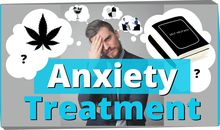What is OCD?
OCD - Obsessive Compulsive Disorder.
What? Isn’t that like my friend who likes things lined up nice in their kitchen?
Not exactly.
If you want to know more about OCD, so you can be helpful rather than hurtful.
And maybe learn more about yourself.
Then keep reading.
I’m going to cover what OCD is, including the 4 main types, and which celebrities have said they’re a bit like this.
You’ll also be wanting to know how you get it and what, if anything, can be done about it.
OCD, like any psychological disorder is on a spectrum.
Some people like things organised or a bit more clean than others, and you may find yourself double-checking you turned off your stove and wondering if you’re a bit OCD.
We call it a DISORDER when it causes significant distress or disruption to your life.
Once checking or handwashing, or a compulsion to count in pairs of 3 in your head to get rid of an unwanted thought, start to delay you getting to work on time, cause you to cancel on a friends, or interfere with your relationships.
Then it becomes a disorder.
About 2.3% of people get diagnosed with OCD. So if you’re at a gathering with 50 people, 1 might have symptoms severe enough to be diagnosed with OCD at some point in their life.
OCD typically starts either in late childhood or between 18 and 25.
It’s generally considered chronic. It’s a long-term condition, that waxes and wanes with stress, triggers, and how you’re doing psychologically at that particular point in your life.
There are reoccurring thoughts (obsessions) like an extreme fear of germs, having things in perfect order, unwanted thoughts involving sex, religion, or harm.
And there will then be an urge to nullify these thoughts with an action (a compulsion), as these thoughts are either seen as being dangerous themselves, or there’s a belief that the thoughts will lead to danger happening.
This action is often repeated over and over, until things feel “right” again.
This can look like excessive cleaning, handwashing, or repeatedly checking on things like whether the oven is still on or the door is locked.
At disorder level, we’re generally looking at more than an hour of this each day.
Symptoms of OCD tend to fall into four major categories:
The first, is Obsessions about contamination with Washing compulsions.
This involves worries about germs, disease, feeling unclean or mentally polluted.
If you have this type of OCD you may be going to great lengths to avoid places and situations associated with feared contaminants (like public bathrooms) and you may be doing protective rituals, such as disinfecting and sterilising, throwing "contaminated" objects away, changing clothes frequently, and designating "clean" areas within your home that are off-limits to others.
If you can’t avoid contaminants, you’ll turn to excessive washing or housecleaning to decontaminate yourself and your possessions.
Contact with a feared contaminant often results in feelings of fear, disgust, and general discomfort, and you may feel a sense of responsibility for spreading contamination to others.
A Celebrity example would be Howie Mandel, from America’s Got Talent. He wrote a book called “Here’s the Deal: Don’t Touch Me,” talking about his germ obsessions that keep him from interacting with his fans.
Next up, there’s: Doubts about accidental harm and checking compulsions.
With this, you would experience intrusive images, impulses, and fears related to the possibility of unintentionally harming yourself or someone else by means of carelessness or negligence.
For example, some of the more common harming fears include burning everyone alive from forgetting to turn off the stove before going to bed, or hitting people while driving.
There are intense feelings of doubt, dread, or uncertainty, as well as a very strong sense of responsibility.
Repetitive checking behaviours are used as a means to neutralize these feelings of dread and uncertainty by attempting to prevent or avert the perceived dangerous consequence.
Let’s pop Jessica Alba in here, who stated that she had OCD about checking doors and appliances. She said, "It was like a panic came over me and I had to do something, and once I did it, I was OK.”
Seems like a good example.
These two types: Washing and Checking OCD are the most common.
Next, we’ve got Symmetry, arranging, counting, and ‘just right’ OCD.
This is what a lot of people think of when they think of OCD.
If you’re this way inclined, you struggle with perfectionism and your compulsions involve repetitive arranging, organizing, or lining up of objects until certain conditions are met.
For example, you may experience intense discomfort if objects are not symmetrically aligned or a certain distance apart from one another.
You may engage in rituals, such as mental arranging and counting, as well as tapping and touching behaviours.
These behaviours can be a result of magical thinking or thought-action fusion: a belief that a thought can cause an event to happen, or not.
"If I don't align the cutlery, my mum will get cancer and I’ll never see her again"
A notable celebrity who may have this kind, David Beckham.
Who said, “I’ve got this obsessive-compulsive disorder where I have to have everything in a straight line or everything has to be in pairs.”
He likened the difficulty of trying to stop obsessions to his addiction to tattoo pain.
The final type is one of unacceptable taboo thoughts with mental rituals to nullify these.
These taboo thoughts are often of a religious, violent, or sexual nature.
This is often referred to as "pure obsessional" or “Pure-O”, due to the lack of overt rituals.
However, with this type, you would be engaging in covert rituals, such as mental compulsions and reassurance-seeking.
The intrusive thoughts with this tend to severely violate your own morals or values.
Like thoughts about sexually molesting children, blasphemous thoughts about religious figures, and impulses to do violent things, such as to push pedestrians into oncoming traffic.
People who have these thoughts typically have no history of violence and don’t act on these thoughts or impulses.
However, because you believe the thoughts are dangerous, you’ll put in a huge amount of mental effort to try to suppress them, arguing with yourself over the morality of your character, trying to cancel-out bad thoughts by replacing them with good thoughts, engaging in excessive prayer or confession, and performing some form of checking. Like reviewing behaviours, or emotions.
Maria Bamford, from Netflix’s “Lady Dynamite,” may have struggled with this.
She said, that she wasn’t able to sleep at night at 9 years old because of a fear that she was going to kill her parents.
This can be a particularly hard form of OCD because of the taboo nature of the thought content.
The fascinating thing is that research reveals that it is perfectly normal to have these intrusive thoughts that come with OCD – most of population does.
However, they flash-up, are waved-off and quickly forgotten.
Whereas, in OCD, huge meaning and danger is attributed to them, causing intense anxiety.
Obviously then you’re going to do something about this perceived danger, so compulsive behaviours ensue, to cancel-out or prevent it.
However, these only serve to further convince the brain that the thoughts are dangerous, as why else would you need to put so much effort into preventing them.
We also get caught-up in safety behaviours, where the brain assumes that the compulsive behaviour you did prevented the harm.
You haven’t gotten sick this week because of the hand washing.
Or, your house hasn’t been broken into because you checked the door.
Even our neurology is caught-up in this.
Research shows that a part of our brain just back from the frontal lobe becomes hyperactive.
It’s the part that detects errors and tells us that something is wrong.
It’s thought to be this hyperactivity that gives us that feeling of discomfort, that ‘not quite right-ness’.
OCD straddles the diagnostic categories of anxiety condition and impulse control disorder.
It’s a real struggle to resist the compulsions that both take up so much of your time, and maintain the disorder. But resisting is the name of the game if you want something more than temporary relief.
Yeah you’ll feel better for a bit if you engage in the compulsion, but the urge comes back.
So, is treatment possible, and how is it done?
Fortunately, yes!
While, like I said earlier, OCD tends to wax and wane depending on how you’re doing at that particular point in your life, it’s very possible to have these waxing periods be far less disruptive to your life.
Exposure with Response Prevention Treatment has been shown to be highly effective in achieving this.
Since the brain is convinced that the not-quite right feeling of discomfort equals danger, something needs to be done to change its mind.
The compulsions are done to prevent the danger, but only serve to reinforce that the danger is real, as you feel a temporary sense of relief after doing it, that your brain takes to mean that you successfully prevented the danger.
Exposure with Response prevention involves triggering that discomfort and then preventing or delaying the protective compulsions to show the brain that they are not necessary.
Your midbrain only learns from experience and this gets it the experience of being safe even without the compulsions.
An example would be, if you’re afraid of contamination from dirt, you would get dirt on your hands and then put off washing them for 20 minutes.
The anxiety shoots up to begin with, as your brain thinks you’re going to die.
But then as time wears-on and you don’t, your brain gets to see that you’re safe and reduces the anxiety level.
Continue with this treatment and the urge to hand-wash becomes less and less of a problem.
As your brain gets repeated experiences of being safe without it.
For some people with OCD, they only struggle with one area and this is enough to get their life back on track.
But for others, the fear just jumps onto something else.
This is because of that core concept – that discomfort equals danger!
With that belief in place, whenever you experience discomfort, or things don’t feel quite right, or just plain wrong, the assumption is that DANGER is coming and you need to DO something!
Unless you want an endless game of whack-a-mole, then you need to address this core, by creating uncomfortable emotions and sitting with them, rather than engaging in preventing imaginary danger.
Introduce yourself to someone in the elevator, cook your food slightly less than you normally would, bring your gumboots into your lounge for a bit.
Find a way to generate some emotional discomfort… and just sit with it.
Do nothing to prevent any danger, and your brain will get to experience that YOU ARE SAFE.
When you believe you are safe, you will feel less anxious.
Seems simple, but you’re going to need to experience it.
It’s hard to do it alone, do get help if you’re struggling with this.
Not only is it hard to carry-out, it’s can often be hard to know if what we’re afraid of is realistic or not.
"Is it actually dangerous if I fail to wash my hands this time?"
"What if I don’t line up my washing powder and my family dies?"
We often need support and lots of it to take the chance, take that risk, and do the exposure.
But until you take that leap, compulsions unfortunately, will continue to rule your life.
I know you’ve got it in you to take that leap and get the improvements you deserve.










